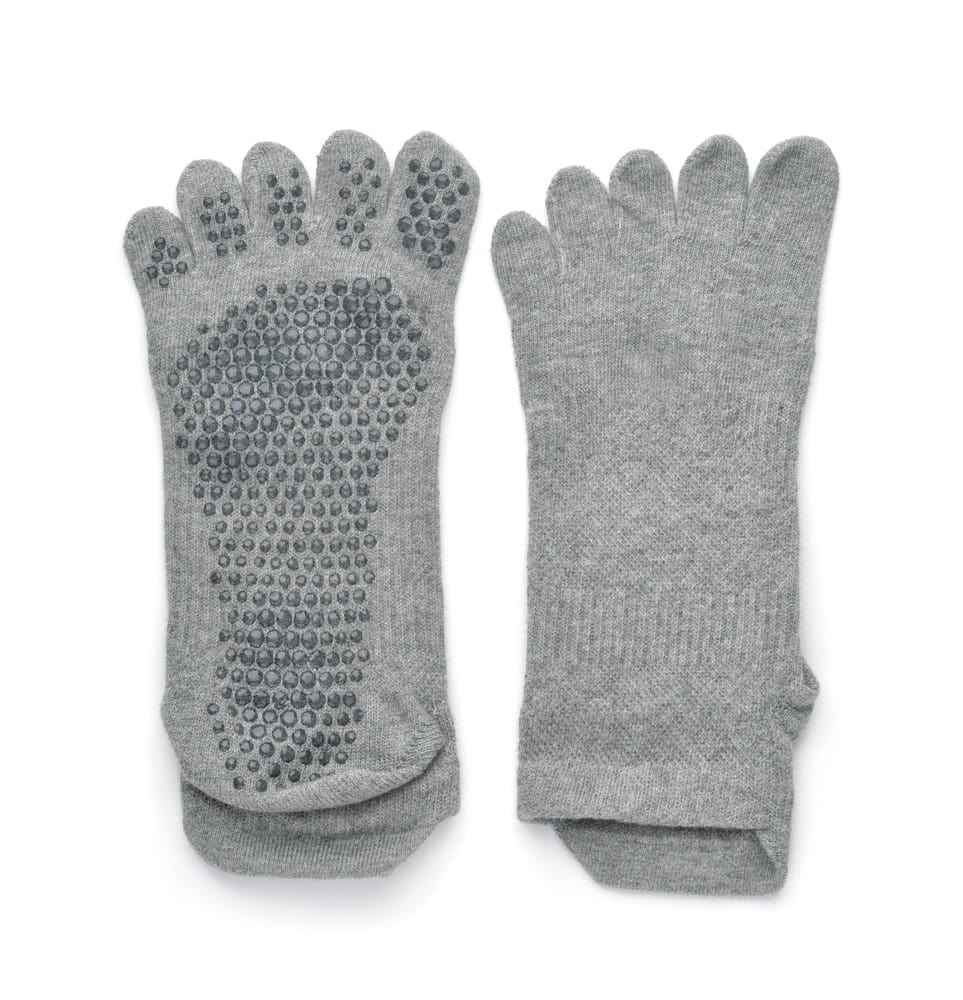Grip socks have a non-slip surface on the bottom, typically made of a rubber or silicone material. These performance socks are worn to provide traction and stability on slippery surfaces, such as in yoga or Pilates studios, and are often required to be worn in these types of classes. They are excellent for other activities such as trampoline jumping, rock climbing, and other sports.
How is Grip Socks Made?
The process of making grip socks can vary depending on the manufacturer and the type of grip sock. However, generally, the process involves the following steps:
- Design and Pattern Creation: The design and pattern for the grip socks are created and adjusted to fit the desired size and shape.
- Fabric Selection: The appropriate type of fabric is selected based on the intended use of the grip socks, such as cotton or a synthetic blend for breathability.
- Cutting and Sewing: The fabric is cut and sewn according to the pattern to create the shape of the grip sock.
- Non-slip Sole Attachment: The non-slip sole, typically made of rubber or silicone, is attached to the bottom of the sock.
- Cushioning and Arch Support: Cushioning and arch support are added to the heel, ball of the foot, and toes as needed.
- Final Inspection and Packaging: The grip socks are inspected for quality and defects and then packaged for distribution.
It’s worth noting that this is a general overview of the process, and different manufacturers may use different techniques and steps to create grip socks.
How Should Grip Socks be Worn?
Non slip socks should be worn on the feet, like regular socks. They are typically worn on bare feet, as the non-slip surface on the bottom of the sock provides better traction when in contact with the skin.
They should fit snugly and comfortably but not be so tight that they restrict circulation or cause discomfort. They should be worn over bare feet and not over shoes or other footwear.
Some studios or gyms require their patrons to wear grip socks during classes and activities, so it’s best to check the specific guidelines of the facility before attending a class.
Who is Grip Socks Suitable for?
Grip socks are generally suitable for anyone who wants to improve their footing and stability during exercise or other activities. Grip socks are suitable for a variety of people, including those who practice yoga, Pilates, and other exercises involving barefoot movements.
They can also be used by people who need help keeping their footing on slippery surfaces, such as in a gym or dance studio. Additionally, grip socks can be beneficial for people with certain medical conditions, such as diabetes, affecting their feet’ sensitivity.
How are Grip Socks Good for Soccer?
Grip socks can be beneficial for soccer players in several ways. Firstly, they can help improve a player’s footing and stability on the field.
The grip on the soles of the socks can help prevent slips and falls, which can be especially useful on wet or muddy fields. Additionally, grip socks can help football players maintain a better grip on the ball when dribbling, passing, or shooting.
Another benefit of grip socks for soccer players is that they can help reduce the risk of injury. The added grip and traction can help prevent sprains and strains caused by slips and falls, and the cushioning in the socks can help absorb impact and reduce the risk of stress injuries.
Grip socks can also be helpful for soccer players who participate in indoor soccer or futsal since the soles of the socks can help prevent slips on smooth surfaces. Grip socks can benefit soccer players by improving footing, stability, and ball control, reducing the risk of injury, and indoor soccer or futsal.
Why Hospitals Use Grip Socks
Hospitals use these non slip grips to help prevent slips and fall among patients and staff. The non-slip soles of these thick socks provide added grip which can be especially important in areas where floors may be wet or slippery, such as in bathrooms or near patient beds.
Grip socks can also help prevent injuries in individuals recovering from surgery or other medical conditions. The added cushioning in the socks can help absorb impact and reduce the risk of stress injuries, while the arch support can help reduce fatigue and strain on the feet.
Grip socks promote hygiene; open-toe grip socks can provide better hygiene as they allow the toes to breathe and dry, preventing fungal or bacterial growth. Hospitals also use grip socks to promote safety, as they can help prevent slips and falls among patients and staff, which can lead to severe injuries.
Some common features of grip socks include:
- Non-slip Soles: The soles of the socks are typically made with a non-slip material, such as rubber or silicone, to provide added grip and traction.
- Cushioning: Many grip socks have a heel, football, and toe cushioning to provide added comfort and support.
- Arch Support: Some grip socks feature built-in arch support to help reduce fatigue and strain on the feet.
- Breathable Material: Grip socks are often made with breathable materials, such as cotton or a synthetic blend, to keep feet dry and comfortable during use.
- Open Toe or Closed Toe: Some grip socks come with open toes, which allows the toes to breathe, while others are closed-toe which provides more protection and also keeps the toes warm
- Elastic Band: Many grip socks have an elastic band that keeps the sock in place and prevents it from sliding around on foot during use.
- Variety of Styles: There are a variety of styles available such as low-cut, ankle, knee-high, and full-length.
- Variety of Colors: Different color options are available, making it easy to match the socks to an outfit.
These are some of the common features, but different brands and types of grip socks may have different features and designs.

Benefits of Grip Socks
Improved Footing and Stability
The non-slip soles of grip socks can help improve footing and stability during exercise and other activities, reducing the risk of slips and falls.
Reduced Risk of Injury
The added grip and traction can help prevent sprains and strains caused by slips and falls, and the cushioning in the socks can help absorb impact and reduce the risk of stress injuries.
Better Ball Control
The soles of grip socks can help players maintain a better grip on the ball when dribbling, passing, or shooting, which can help improve performance in sports like soccer.
Increased comfort
The cushioning and arch support found in many grip socks can help reduce fatigue and strain on the feet during exercise or other activities, making them more comfortable to use.
Increased Hygiene
Open-toe grip socks can provide better hygiene, allowing the toes to breathe and dry, preventing fungal or bacterial growth.
Indoor and Outdoor Use
Grip socks can be used for indoor and outdoor activities and sports, including yoga, Pilates, soccer, and other types of exercise that involve barefoot movements.
Variety of Styles
The variety of styles available, such as low-cut, ankle, knee-high, and full-length, can be suitable for different activities and personal preferences.
Variety of Colors
Different color options can easily match the socks to an outfit. More so these grips socks can be customized for team socks, official socks, yoga socks and meet various needs.
Overall, grip socks can provide several benefits that can help improve performance, reduce the risk of injury, and increase comfort during exercise and other activities.
How to Buy the Best Grip Socks
When buying grip socks, here are a few things to consider:
- Cushioning: Consider the level of cushioning that you need. Some people prefer more cushioning in the heel and toes, while others prefer less.
- Arch Support: If you have flat feet or experience arch pain, look for grip socks with built-in arch support.
- Material: Look for grip socks made of breathable materials, such as cotton or a synthetic blend, to keep your feet dry and comfortable.
- Style: Consider the style of the grip socks, whether you prefer low-cut, ankle, knee-high, or full-length.
- Brand Reputation: Research the brand reputation before making a purchase. You may look for customer reviews and feedback on the brand or product.
- Size and Fit: Make sure to select the appropriate size for you and check the fit. It should not be too tight or too loose.
- Price: Compare the price of different grip socks, and also consider the features and quality of the product.
By considering these factors, you should be able to find a pair of grip socks that meets your needs and preferences.

Frequently Asked Questions on Grip Socks
How do I Care for my Grip Socks?
It is recommended to wash grip socks in cold water and air dries them. Avoid using bleach or fabric softeners; do not put them in the dryer.
Are there Different Styles of Grip Socks?
Yes, various styles are available, such as low-cut, ankle, knee-high, full-length, and open-toe or closed-toe.
Can I Wear Grip Socks with Shoes?
It depends on the type of shoe and the activity you are doing. Some shoes, like sneakers, may work well with grip socks, while others may not. It’s best to check the manufacturer’s recommendations or try them out yourself to see what works best for you.
How Long do Grip Socks Last?
The lifespan of grip socks depends on several factors, such as the quality of the materials used, the frequency of use, and the level of care given to the socks. On average, grip socks can last several months to a year with regular use and proper care.
To prolong the life of your grip socks, it is vital to wash them regularly and avoid subjecting them to excessive heat or bleach. However, if you notice any wear and tear, such as holes, fraying, or worn-out soles, it may be time to replace them. Additionally, if the grip on the soles is no longer as effective as it used to be, it may also be time to replace them.
Does Grip Socks Cause Blisters?
Grip socks are designed to provide added grip and traction, which can help reduce the risk of slips and falls. They are typically made with breathable materials and have cushioning to provide added comfort. However, like any footwear, grip socks may cause blisters if they don’t fit properly, if the material rubs against the skin, or if you are breaking in new socks.
To minimize the risk of blisters, it’s essential to choose the right size and gradually break in new socks. When first using grip socks, it’s a good idea to wear them for short periods and gradually increase the duration of use. If you notice any areas of discomfort or rubbing, it’s essential to address the issue by adjusting the fit or choosing a different type of sock.
It’s also recommended to keep your feet clean and dry, as moisture can increase the risk of blisters. If blisters do occur, it’s essential to keep them clean and covered to prevent infection.
Overall, grip socks, if worn correctly and with the correct size and fit, do not cause blisters, but as with any footwear, if they don’t fit correctly or if the material rubs against the skin, they may cause blisters.
Can my Grip Socks Order be Customized?
It depends on the company or manufacturer of the grip socks. Some companies offer customization options, such as custom logos or designs, while others do not.
Customization options can include:
- Customized logo or designs on the grip socks
- Customized size and color options
- Customized packaging
If you’re interested in customizing your grip sock order, check with the company or manufacturer to see what options are available. Remember that custom orders may take longer to process and have higher minimum order quantities and costs.
Not all companies and manufacturers offer customization options, so you should inquire before placing an order.
Qualities of a Good Grip Socks
A good pair of grip socks should have the following qualities:
- Non-slip Soles: The soles of the socks should be made of a non-slip material, such as rubber or silicone, to provide good grip and traction.
- Cushioning: The grip socks should provide enough cushioning in the heel, ball of the foot, and toes to provide added comfort and support.
- Arch Support: Good grip socks should have built-in arch support to help reduce fatigue and strain on the feet.
- Breathable Material: The grip socks should be made of breathable materials, such as cotton or a synthetic blend, to keep feet dry and comfortable.
- Durable: A good pair of grip socks should be made of high-quality materials that are durable and long-lasting.
- Fit and Size: Good grip socks should fit well and come in a range of sizes to fit various foot sizes.
- Variety of Styles: Good grip socks should come in a variety of styles, such as low-cut, ankle, knee-high, full-length, and also open-toe or closed-toe.
- Variety of Colors: Good grip socks should come in various colors to match personal preferences.
- Brand Reputation: Good grip socks should come from a reputable brand with positive customer feedback and reviews.
- Affordable: Good grip socks should be reasonably priced, considering the features and quality of the product.
By keeping these qualities in mind, you can ensure that you purchase a high-quality pair of grip socks that will provide the support, stability, and comfort you need. We manufacture the best grip socks in wholesale. Please, fill out the contact form to get in touch with us.










